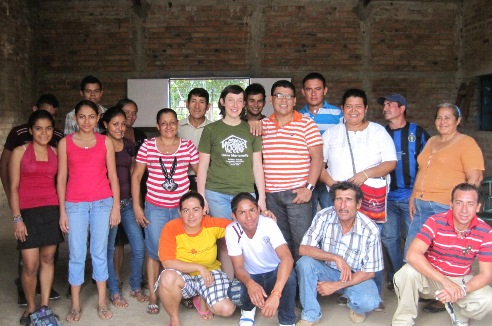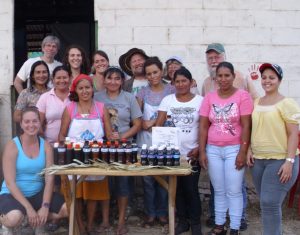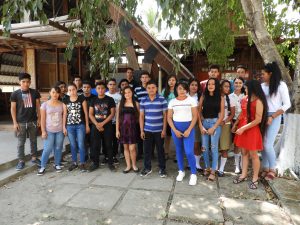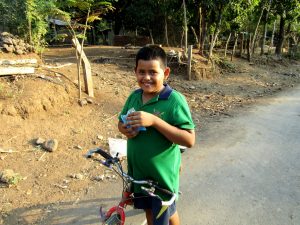Community Development Projects, Get Involved
Austin Sister Cities Volunteer Learning to Eat, Sleep, and Breathe Solidarity
We talk a lot here at Sister Cities about solidarity, emphasizing that our sister communities are working “in solidarity” with one another, but what does that mean? And even more important, what does it look like in practice?
I arrived here in El Salvador on January 5th to start my six month volunteering adventure with Sister Cities. I will be volunteering in the national office of Sister Cities in San Salvador, the regional office of the CRIPDES San Vicente team, and in Guajoyo, Austin´s sister community. As an Austenite and member of the Austin committee, I am excited to get to observe and be involved in the projects that the committee has helped support.
My role here is a constantly fluctuating combination of accompanying the social, developmental, and political processes of Sister Cities, CRIPDES and grassroots organizations and organized communities, and working directly planning assemblies for scholarship students, assisting in the English classes at the Guajoyo primary school, drafting project work plans, etc. In short, my role is to eat, sleep, and breathe solidarity.
I learned a lot from the group of university students who came down from Madison, Wisconsin in January for a 2-week-long delegation. The Madison sister city group was one of the original founders of the organization, and their sistering relationship has grown and expanded in the 20 plus years since its formation. On the ground in Wisconsin, the group has taken the form of a leftist activist community organizing base; that is to say, the group is involved in a variety of issues locally from environmental concerns to national social movements like Occupy. They use their relationship with Arcatao, their sister community, to compare notes and share support on these issues. The idea is that we are all involved in our own fights or luchas that are based on geography, timing, and culture. But they are all part of a larger struggle to protect the environment and to give a voice to el pueblo, because in the end, we are all part of the same pueblo.
The foundation of solidarity is communication – how else can we know what is happening with our brothers and sisters around the world? But the world is huge, and no human is capable of knowing what is going on in all its disperse corners. That is why sistering relationships exist, because although we as humans don’t have the capacity to fit the hold world in our consciousness, we are undoubtedly made to be relational. Maybe I can’t totally understand the big social and political systems of globalization and capitalism, but I can understand when a friend is suffering, and I can live in solidarity with their struggle.
That’s the idea here in Guajoyo. When all the regional CRIPDES teams met a couple of weeks ago to evaluate the past year’s work and plan for 2013, there was a lot of talk a lot about focusing more on the solidarity aspect of sistering relationships. It is much easier to send money or wait for a community to ask for support for some specific project, but that’s not the whole idea. Communities and committees should be communicating with one another and sharing life experiences. They should be visiting one another, and on the US side we should remember that these relationships never meant to be a one-way. We have much to learn from these communities, especially when it comes to organization and active participation in government and culture. In El Salvador, I am always thinking about our struggles in the United States and how they relate to the struggles down here. Just one example is the food crisis surrounding how cheap genetically modified and pesticide polluted food has infiltrated everywhere and it is hurting our health and environment. That’s a problem that is as urgent for us in the States as it is in El Salvador, and there are things that we can learn from one another in the fight against this threat.
One month in, and I’m just getting started on this path of solidarity with El Salvador that will undoubtedly last a lifetime. I have been inspired by what I have experienced, and looking forward to everything else I know I will learn in the next few months. Most of all I am excited to be going down a path so many others are already on, compas here in El Salvador and you all in the States. The road seems long and bumpy -and it sure is hot, at least here in San Vicente – but I am glad to be walking down this path with all of you.
-Catie Johnston
From Paper to Reality
Posted on austinelsalvador.wordpress.com on February 18, 2013
Now that I’ve been here for nearly 2 months, I’m finally beginning to get into the work of being a Sister Cities volunteer. Like I said in my last post, things move slowly here. But I am learning about the decision making process and what the trabajo organizativo (organizational work)looks like in Guajoyo and in El Salvador in general.
The Austin committee is funding several projects in Guajoyo this year, and I’ve been involved in the slow process of seeing those projects go from paper to reality. The project I’m most involved in, as it involves the youth and that is one of my areas of focus while I’m here, is a youth-run cyber café. The Austin committee collected 4 used computers to donate, which the youth hope to use to start a community space that brings technology to students and adults alike. As it is, anyone who wants to use a computer has to pay 50 cents to take the bus or pickup (which only pass about 6 times a day) into San Nicolas to go to the cyber café, which charges $1/hour for internet use. Such an excursion ends up costing at least $2 (transportation there and back plus time in the café) and at least 2 or 3 hours. It’s a great project that, once in effect, will be a huge support not only to Guajoyo but to the surrounding communities.
But getting it off the ground is quite a feat.
First, it requires gathering a group of dedicated community members – in this case youth – who are going to see the project through. We planned a preliminary meeting last week on Wednesday, but nobody showed up so we moved it to Thursday. Thursday only the president of the community council, 2 youths, and myself showed up. We ironed out some details, like sending a few people out to gather cost estimates for the project (for things like an internet modem, desks, printer, etc), and we planned a follow up meeting for this coming Tuesday – tomorrow.
The process of calling a meeting is still something that bewilders me, a product of the facebook generation. I am used to meetings being planned at least a week in advance and details about the meeting being published online and in some cases in writing. Here, in this community of oral communication, planning a meeting just means informing the right people, and they spread the news through the community. They go to the soccer field at 4:00 when there is sure to be youth gathered. They go to the church on Saturdays and Wednesdays where people gather weekly. Or, they just walk up and down the main road poking their heads into the yards of people’s houses as they pass by, shouting the important information to residents as they lounge in their hammocks or pat tortillas by the fire.
Then the meeting itself, if it is scheduled for 3:00, people begin to show up at 3:30and fill the plastic chairs arranged haphazardly in spots of shade. By 4:00 or 4:30 the meeting begins, and an hour into the meeting people finally warm up and start to contribute.
Meeting with the Junta Directiva
The idea for the cyber café came from the youth, and has evolved since it was first mentioned as an idea. Since a certain amount of funds are available, it is the job of the youth committee to figure out how to execute the project within the limitations of available funds.
There is an irony in the speed of decision making here. On the one hand, it moves at a slug’s pace, but on the other hand, decisions are made swiftly without waiting for full attendance or participation. At meetings I’ve attended in the US, it seems that decisions made usually require follow up and the input of individuals not in attendance. But here, those who show up are those who have a say. If the meeting is called to elect a new committee, those who show up are the candidates, and it’s tough luck for those who don’t. So I hope that enough youth who are really interested in seeing this cyber café project through show up to the meeting tomorrow, because those in attendance will be the ones who design the project and make decisions.
One critique I have to offer, and that I brought up in our last meeting, was the need to constantly come back to the question: “How will this benefit the community?” The cyber café, for instance, will definitely benefit the community, but the moments when the conversation got lost down an unproductive path was when they strayed from this foundational question.
I’m getting used to the whole process, and even initiated two meetings of my own this week. We’re starting an English practice group for those who want to improve their English outside of the classroom. The second meeting was on the very important subject of dance in the community. I called it a dance class, and I did teach some swing dance moves, but it was really just an excuse to get together and dance on a Saturday morning. I’m looking forward to more of these meetings.
Read more on her blog.




